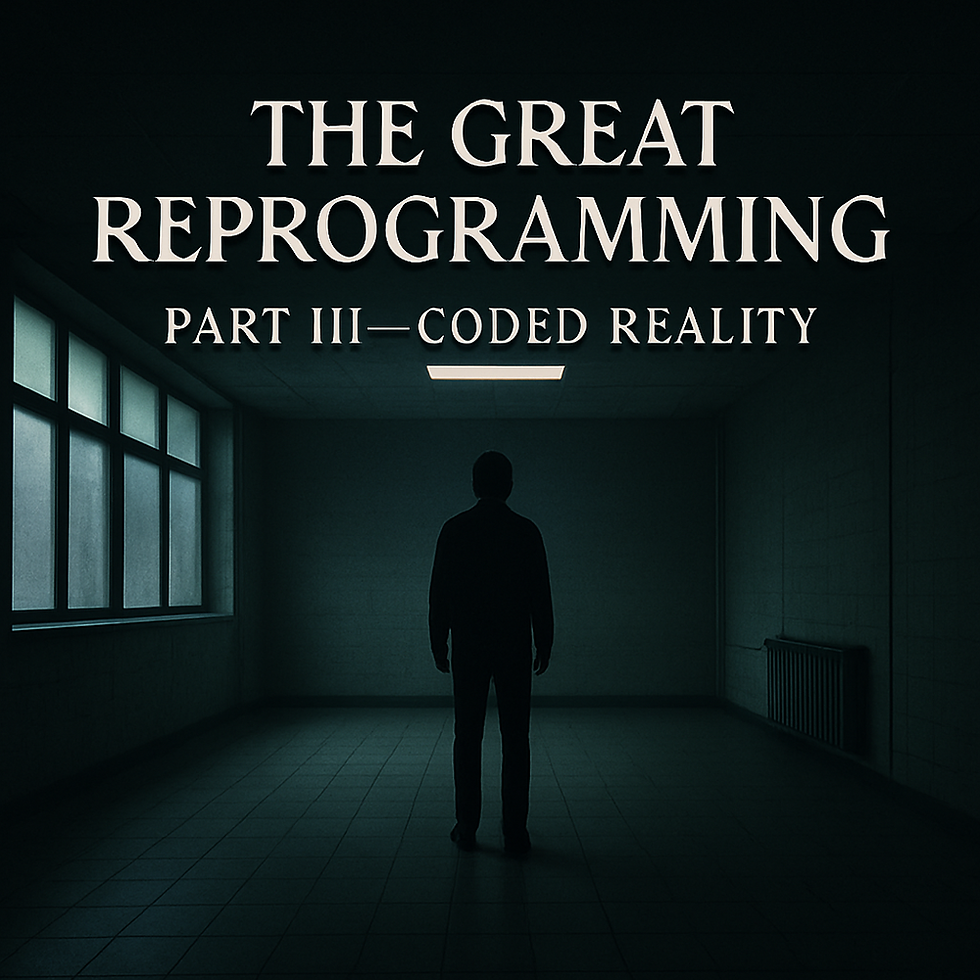The Great Reprogramming: Part III - Coded Reality
- nvtvptpenrose
- Oct 8
- 4 min read
You were born into a script that began long before you opened your eyes. Before language, before choice, before memory, a system of signals was already moving through your skin, your breath, your orientation to space. The world was not offered to you as something to explore. It was shaped to receive you in a particular way, and in that shaping, it began to install a rhythm that did not rise from within. It was imposed gently, constantly, and without pause.

This shaping did not rely on a single moment. It was not announced. It arrived through arrangement. The layout of the room. The intensity of the light. The repetition of sound in sterile hallways. The body does not reason with these things. It receives them as fact. It adapts because that is what the body is built to do. But when it adapts to environments that are misaligned with its own nature, something begins to dim. Not in the sense of failure, but in the sense of forgetting.
The forgetting begins with pace. Human movement has its own tempo, born of muscle, breath, emotion, and environment. But modern environments are not built to match that tempo. They are constructed to direct, to control, to standardize. The floor is flat. The hallway is narrow. The destination is fixed. You walk because the structure implies forward motion. You sit because the room is filled with chairs. You enter because the door is open, and you stay because the door closes behind you. Nothing needs to be said. The design itself does the work.
This design does not evolve from living systems. It emerges from a desire to manage bodies and predict behavior. It introduces a geometry that trains the nervous system to align with external cues rather than internal states. The light above you stays the same whether morning or night. The sound of the bell rings even when you are not ready to stop. The schedule moves forward even when your attention has not landed. Over time, the body begins to treat these signals as natural. It synchronizes with the structure even if it costs clarity, presence, and health.
Most buildings are not created for human thriving. They are created for containment and function. Their edges are hard. Their colors are muted. Their furniture is built to fit the system, not the spine. You learn to sit still, not because stillness serves you, but because stillness is easier to manage. You learn to speak in turns, not because silence has been mastered, but because unpredictability slows the machine. What begins as adaptation slowly becomes identity. You believe you are obedient. You believe you are distracted. You believe you are lazy, restless, disorganized, unmotivated. These are not truths. These are signals produced by the friction between your biology and your environment.
Once the friction becomes familiar, it starts to vanish from awareness. The discomfort stays, but the source becomes hidden. You may feel tired without cause, tense without memory, anxious without reason. The body continues to speak, but the language is no longer recognized. This is the deeper script. It is not read through words. It is absorbed through exposure. The light, the tone, the material, the sequence — all of it becomes a form of silent instruction. It tells the body when to prepare, when to suppress, when to release. The more you live inside this sequence, the more natural it feels. And once it feels natural, it becomes invisible.
There is no intention required for this script to run. It does not depend on malice. It persists through design, tradition, and repetition. It is reinforced by architecture, enforced by routine, and preserved through generations who pass it down without question. The moment a child begins to override their own curiosity to fit a schedule, the script deepens. The moment a worker suppresses the need to rest in order to meet a deadline, the loop continues. The script is not imposed with force. It is absorbed through reward and exhaustion. The body slowly gives itself away in exchange for approval, belonging, or survival.
Yet beneath all of this, something remains untouched. No structure has erased it. No institution has broken it. It waits quietly in the moments between tasks. It stirs when you leave the building and enter a place that has no clock. It sharpens when you stand near water or walk without direction. It does not argue with the script. It simply exists underneath it, always ready to reawaken. This is the original rhythm — the one that does not come from programming. It lives in the soles of your feet and in the spine that realigns when you stop performing.
To return to this rhythm, you do not need to destroy anything. You do not need to escape. You need only to begin noticing what your body has already learned to ignore. Pay attention to how the light feels. Notice what your breath does in each space you enter. Listen for the moments when your nervous system softens. These signals are small, but they are trustworthy. They speak from inside the current, not from the structure built above it.
Every environment you occupy speaks to your biology. You do not need to fight it. You only need to recognize what it is saying. With that awareness, the script loses its grip. The nervous system recalibrates. The spine remembers its shape. The senses return to the surface. There is no rebellion in this. There is only remembering. And through remembering, the deeper pattern begins to rise again.
Part I here.
Part II here.
Part III here.
Our bodies were never broken.
They were responding to the room.




Comments